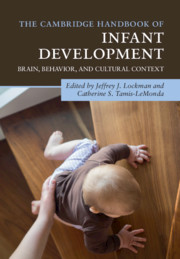Book contents
- The Cambridge Handbook of Infant Development
- The Cambridge Handbook of Infant Development
- Copyright page
- Dedication
- Contents
- Illustrations
- Contributors
- Preface
- Part I Foundations
- Part II Perceptual Development
- Part III Cognitive Development
- 12 Infant Memory
- 13 Infant Physical Knowledge
- 14 Infant Categorization
- 15 Early Knowledge About Space and Quantity
- 16 Infant Learning in the Digital Age
- Part IV Action
- Part V Language
- Part VI Emotional and Social Development
- Index
- References
12 - Infant Memory
from Part III - Cognitive Development
Published online by Cambridge University Press: 26 September 2020
- The Cambridge Handbook of Infant Development
- The Cambridge Handbook of Infant Development
- Copyright page
- Dedication
- Contents
- Illustrations
- Contributors
- Preface
- Part I Foundations
- Part II Perceptual Development
- Part III Cognitive Development
- 12 Infant Memory
- 13 Infant Physical Knowledge
- 14 Infant Categorization
- 15 Early Knowledge About Space and Quantity
- 16 Infant Learning in the Digital Age
- Part IV Action
- Part V Language
- Part VI Emotional and Social Development
- Index
- References
Summary
Researchers and parents alike have long assumed that experiences that occur during infancy are fundamental to both behavioral and cognitive development. Paradoxically, not only do adults typically fail to recall events that occurred prior to the age of 3, but until the middle part of the twentieth century, there was limited evidence of long-term retention during the infancy period itself. By way of example, although acquiring our first words or taking our first steps was undoubtedly monumental at the time it occurred, we have no conscious recollection of achieving these milestones. In contrast, our memories of other important achievements that took place slightly later in development, like our first day of school or the first time we rode a bike without training wheels, often survive the test of time and eventually form part of our autobiography.
Keywords
- Type
- Chapter
- Information
- The Cambridge Handbook of Infant DevelopmentBrain, Behavior, and Cultural Context, pp. 341 - 362Publisher: Cambridge University PressPrint publication year: 2020



